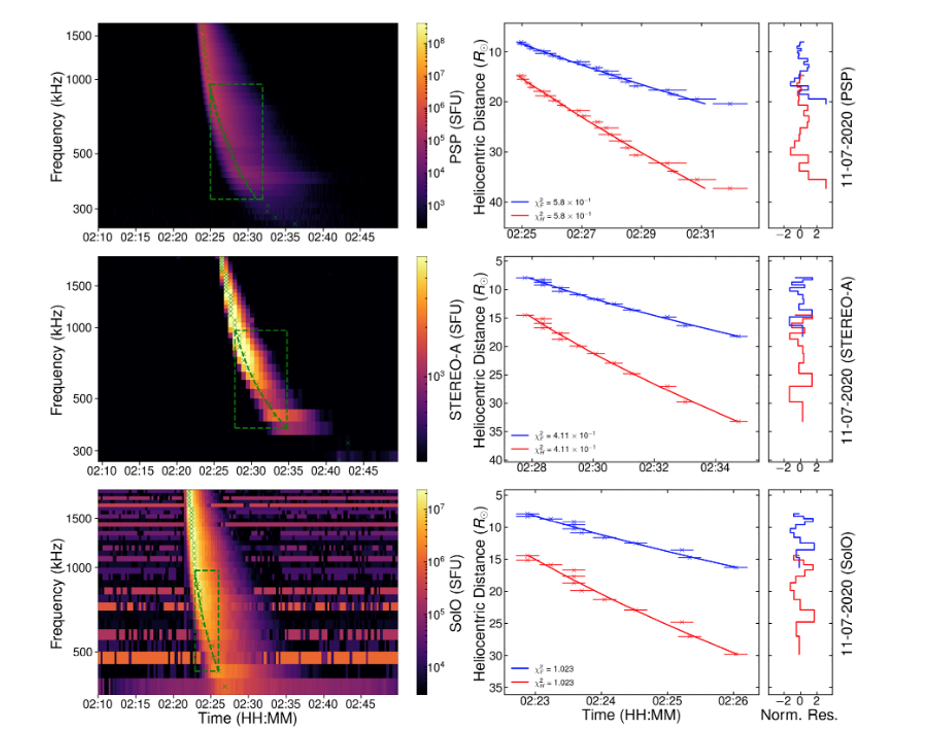Electron beams accelerated in solar flares and escaping from the Sun along open magnetic field lines can trigger intense radio emissions known as type III solar radio bursts. However, the propagation dynamics of these electrons is still poorly understood and observationally constrained (Dulk et al 1987, Krupar et al 2015). Historically, single-spacecraft measurements have suggested deceleration but suffered from large uncertainties due to unknown source position. By leveraging four spacecraft positioned at different heliospheric longitudes, one can obtain a multi-perspective view that allows them to localize the burst sources.
Using simultaneous observations from four spacecraft, Parker Solar Probe (PSP), STEREO-A, Solar Orbiter, and Wind, Azzollini & Kontar, 2025 determine the positions, velocities, and accelerations of type III burst exciters, correcting for source-spacecraft angular separations (see Figure 1 and Figure 2).

Figure 1: Type III burst peak fluxes measured by four different spacecraft (left) and spacecraft positions (right) in HEE coordinates during the 2020 July 11 (2:30 UT) event. The direction of maximum directivity is found using the peak fluxes from STEREO-A, PSP, Wind, and SolO at 979 kHz.

Figure 2: Dynamic spectra (left) and frequency–time (right) on 2020 July 11 by the PSP, STEREO-A, and SolO spacecraft (from top to bottom). For each spacecraft, the peak-flux frequencies (and the fit) are plotted on the right for the times–frequencies selected by the green dashed box, containing peak-flux points (green “X” symbols), along with their fitted curve (green dashed line), while the fitted positions of the emitter as a function of time and the normalized residuals from the fit are shown on the right. Blue and red lines correspond, respectively, to the Fundamental and Harmonic components.
The analysis of a number of type III bursts reveals that the exciter velocities decrease with heliocentric distance approximately as ($u(r)( \propto r^{-0.37 \pm 0.14}$ ), while acceleration decreases as ( $a(r) \propto r^{-1.71 \pm 0.20} $).
To interpret these results, a simple gas-dynamic model (see simulations by Kontar, 2001) describing the electron beam as a plateau distribution interacting resonantly with Langmuir waves in a plasma whose density decreases radially is developed. The model predicts a velocity scaling and acceleration scaling, in remarkable agreement with observations. This agreement supports the hypothesis that plasma density gradients govern the beam deceleration by modifying the Langmuir wave spectrum and inducing momentum loss through wave refraction and damping.
Intriguingly, the observations also show differences in velocity and acceleration of the same type III using dynamic spectra observed by different spacecraft. We suggest the difference could be related to the additional time delay caused by radio-wave scattering between the spacecraft and the source.
Conclusion
This study advances our understanding of type III solar radio bursts by combining observational data from multiple spacecraft with theoretical modeling. The findings demonstrate the critical role of plasma density inhomogeneity in shaping the dynamics of electron beams and their associated radio emissions. By addressing the limitations of single-spacecraft observations and providing a robust theoretical framework, the study lays the groundwork for future research into the complex interactions between solar energetic particles and the heliospheric plasma.
Additional info: The nugget is based on the recently published paper by F. Azzollini and E. P. Kontar, 2025, The Astrophysical Journal, 989 118, DOI: 10.3847/1538-4357/adee22
References
Dulk, G. A., Goldman, M. V., Steinberg, J. L., & Hoang, S. 1987, A&A,173, 366
Kontar, E. P. 2001, Solar Physics, 202, 131
Krupar, V., et al. 2015, A&A, 580, A137
